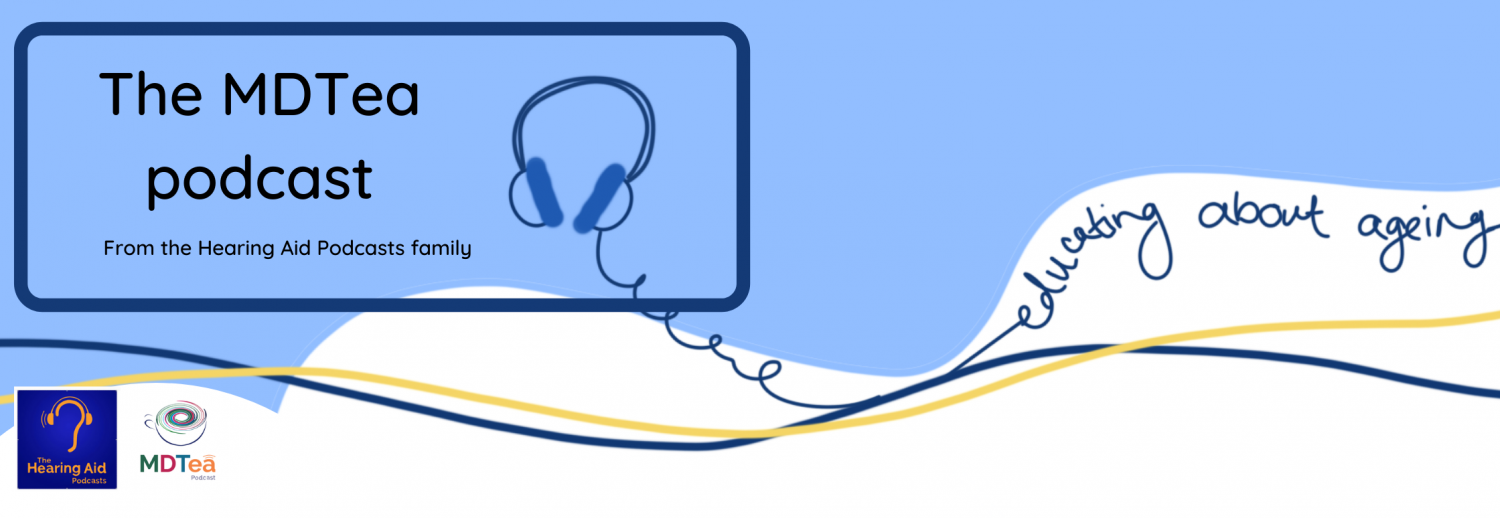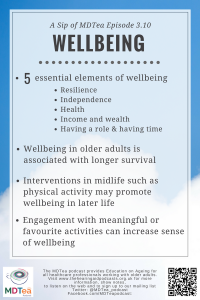Episode 3.10 Wellbeing
Presented by:
Dr Iain Wilkinson (Consultant Geriatrician East Surrey Hospital)
Dr Jo Preston (Consultant Geriatrician St George’s Hospital)
Tracy Szekely (Senior Lecturer in Occupational Therapy University of Brighton)
Gaynor Sadlo (Former Professor of Occupational Science University of Brighton, Visiting Professor, Charles University Prague)
Broadcast date: 20th June 2017
Click here for a PDF of this infographic
CPD log
Click here to log your CPD online and receive a copy by email.
Episode 3.10 Show Notes – Wellbeing
Click here to download a PDF version of the show notes
Learning Outcomes
Knowledge:
- To understand the midlife interventions which may promote later life wellbeing
- To realise the importance of the default mode network in neuroscience and its role in reducing stress through task performance.
- To understand the role of occupations and positive engagement for wellbeing in later life.
Skills:
- To be able to use meaningful and favourite activities to promote health in later life.
- To prevent occupational deprivation in later life.
Attitudes:
- To increase knowledge of flow type activities and occupations to increase participation in activities and creativity.
- To appreciate that humans have evolved as creative beings and by not doing this we may become ill.
Social Media Spots this week
Survey on delirium management: Nursing Critical Care Journal
10 ways to be more mindful at work by @ShamashAlidina #mindfulness pic.twitter.com/X7ZOag5kFG
— Everyday Mindfulness (@mindfuleveryday) May 22, 2017
Definitions
Wellbeing: simply put the state of being comfortable, healthy or happy. The definition however is tricky and is different from quality of life.
Discussion
Wellbeing is multifaceted – a combination of physical and mental wellbeing is important.
The Institute for Public Policy Research (IPPR, 2009) identifyied five essential elements of well-being as:
- Resilience
- Independence
- Health
- Income and wealth
- Having a role and having time
What we as professionals may mean by wellbeing may differ from what our patients / clients think.
For example a study from 2002 looked at two different definitions of successful ageing in the prediction of wellbeing
a) a self-rating scale
b) Rowe and Kahn’s criteria (the absence of disease, disability and risk factors such as maintaining physical and mental functioning and active engagement with life).
Of 867 participants aged 65-99, the percentage rating themselves as aging successfully was 50.3% compared with 18.8% classified according to Rowe and Kahn’s criteria. Although absence of chronic conditions and maintaining functioning were positively associated with successful aging for both definitions, many participants with chronic conditions and with functional difficulties still rated themselves as aging successfully.
Broadly speaking there are 3 methods of evaluation of wellbeing(lancet paper below):
- Life evaluation refers to peoples’ thoughts about the quality or goodness of their lives, their overall life satisfaction or sometimes how happy they are with their lives. Measurement uses such questions as the Cantril Ladder, wherein individuals are asked to place themselves on an 11-step ladder with ‘worst possible life’ representing the lowest rung and ‘best possible life’ the top rung.
- Hedonic wellbeing refers to everyday feelings or moods such as experienced happiness (the mood, not the evaluation of life), sadness, anger, and stress, and is measured by asking respondents to rate their experience of several affect adjectives such as happy, sad, and angry.
- Eudemonic wellbeing focuses on judgments about the meaning and purpose of one’s life; because the construct is more diverse, several questionnaires tapping various aspects of meaning have been developed.
Wellbeing is also important:
- Analyses from the English Longitudinal Study of Ageing (ELSA), found that eudemonic wellbeing is associated with longer survival;
- 29.3% of people in the lowest wellbeing quartile died over the average follow-up period of 8.5 years compared with 9.3% of those in the highest quartile. Associations were independent of age, gender, demographic factors, and baseline mental and physical health.
- They conclude that the wellbeing of the elderly is an important objective for both economic and health policy.
Exercise
We talked about its effects on cognition in the previous episodes on early dementia treatments (head on over to the end of series 2 for that episode).
- The WHO Active Ageing Policy Framework says: Participation in regular, moderate physical activity can delay functional declines. It can reduce the onset of chronic diseases in both healthy and chronically ill older people. For example, regular moderate physical activity reduces the risk of cardiac death by 20–25 per cent among people with established heart disease. It can also substantially reduce the severity of disabilities associated with heart disease and other chronic illnesses. Active living improves mental health and often promotes social contacts. Being active can help older people remain as independent as possible for a long period of time. It can also reduce the risk of falls. There are thus important economic benefits when older people are physically active. Medical costs are substantially lower for older people who are active (WHO, 1998).
- For a nice review of the evidence check out this article from Age UK
Nutrition
- Limited evidence suggests that a Mediterranean diet with no restriction on fat intake may reduce the incidence of cardiovascular events, breast cancer, and type 2 diabetes mellitus but may not affect all-cause mortality…. But… Few trials; medium risk-of-bias ratings for many studies; low or insufficient strength of evidence for outcomes; heterogeneous diet definitions and components.
- The guideline includes recommendations on promoting a healthy lifestyle to reduce the risk of or delay the onset of disability, dementia and frailty by helping people to: stop smoking; be more active; reduce their alcohol consumption; improve their diet and lose weight and maintain a healthy weight if necessary.
Meaningful activities
Engaging with activities we really enjoy – meaningful activities – makes us feel well. Occupational science is based around this idea, that when people are deeply engaged in activities, and their mind is occupied with things things they enjoy, this has a beneficial effect.
Flow state
When deeply engrossed in an activity, people often describe a sensation of time passing more quickly, or being able to ‘forget themselves’. This is flow, or optimum human functioning, and people report feelings of calm or wellbeing after an experience of this state.
Default mode network
Also called the self awareness network. This is intrinsic activity of the human brain – social thinking/self induced thinking that happens in rest state- not deliberate thinking. It is thought to exist to enable humans to process and reflect on complex social interactions, and as a result content is analytic, often self-critical thoughts. These types of thoughts can be heightened in depression.
The default mode network becomes active when not doing an activity, and is dampened when we are doing a flow activity that takes all of our attention.
Why does it feel good to forget ourselves?
Social threat response- when we think about ourselves it can be stressful, and make us feel vulnerable. Reducing our awareness of self reduces this activity in the amygdala.
Resources
| Curriculum | Area |
| NHS Knowledge Skills Framework | Suitable to support staff at the following levels:
Personal and people development level 1-3 Service improvement level 1 Equality and Diversity level 1-2 |
| Foundation Curriculum 2012 | 2.1 Treats patient as centre of care
6.1 Lifelong learning 10.5 Health promotion, patient education and public health |
| Foundation Curriculum 2016 | 2. Patient centred care
4. Self-directed learning 16. Demonstrates understanding of the principles of health promotion and illness prevention |
| Core Medical Training | Common competences:
System specific competences:
|
| GPVTS program | Section 3.01 – Healthy People: promoting health and preventing disease
Section 3.05 – Care of older adults
|
| ANP (Draws from KSF) | Section 20. The patient as central focus of care
Section 35. Psychological, social, cultural, ethnic and economic factors |





